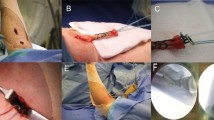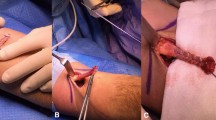Abstract
Background
Anatomic reconstruction of distal biceps tendon ruptures may prevent loss of strength and the associated restrictions in everyday life. We investigated whether an anterior single-incision approach is effective in anatomically reconstructing the tendon footprint using a bicortical endobutton and whether this affects postoperative force development.
Methods
All adult patients (≥ 18 years of age) with at least 1 year of follow-up after acute distal biceps tendon rupture treated by bicortical endobuttons using the single-incision technique were eligible for inclusion. Radiographic assessment included analysis of the anatomic footprint. Functional follow-up included range of motion, objective and subjective performance measures, flexion and supination forces, complications, and rates of return to sport and to work. Mean flexion and supination forces were statistically compared between the affected and unaffected side.
Results
After a mean follow-up of 31.5 ± 16.6 months, satisfactory results were obtained for 31 male patients (mean age: 50 ± 9 years). Postoperatively, supination strength measures (starting force, maximum force, terminal force, and average force) were significantly lower on the affected side vs. the unaffected side. This involved the dominant arm in 58% of cases. The tendon was anatomically reconstructed in 4 out of 31 cases (12.9%). On average, return to work was 6.2 ± 4.3 weeks and return to sports was 5.0 ± 2.9 months. The return-to-work and return-to-sports rates amounted to 100%.
Conclusion
Supination strength suffers after distal biceps tendon reconstruction relative to the unaffected side. In most cases (87.1%), the distal biceps tendon could not be reattached to its anatomic footprint via an anterior single-incision approach. Intraoperative radiographic control might improve anatomic positioning of the refixation and remains to be evaluated.
Zusammenfassung
Einleitung
Die anatomische Rekonstruktion von Rupturen der distalen Bizepssehne kann einen erheblichen Kraftverlust und die damit verbundenen Einschränkungen im Alltag verhindern. In der vorliegenden Arbeit wurde untersucht, ob ein anteriorer Single-Incision-Zugang bei der anatomischen Rekonstruktion des Sehnen-Footprints mit einem bikortikalen Endobutton erfolgreich ist und ob dies die postoperative Kraftentwicklung beeinflusst.
Methoden
Alle erwachsenen Patienten (> 18 Jahre) mit einer Nachbeobachtungszeit von mindestens einem Jahr nach einer akuten distalen Bizepssehnenruptur, die mit bikortikalen Endobuttons in Single-Incision-Technik behandelt wurde, wurden in die Studie aufgenommen. Die Patienten wurden hinsichtlich ihres klinischen Verlaufs nachbeobachtet. Die röntgenologische Beurteilung umfasste die Analyse des anatomischen Footprints. Die funktionelle Nachuntersuchung erfasste den Bewegungsumfang, objektive und subjektive Leistungsmessungen, Flexions- und Supinationskräfte, Komplikationen sowie die Wiederaufnahme des Sports und die Rückkehr an den Arbeitsplatz. Die mittleren Flexions- und Supinationskräfte wurden statistisch zwischen der betroffenen und der nicht betroffenen Seite verglichen.
Ergebnisse
Nach einer mittleren Nachbeobachtungszeit von 31,5 ± 16,6 Monaten wurden bei 31 männlichen Patienten mit einem Durchschnittsalter von 50 ± 9 Jahren zufriedenstellende Ergebnisse erreicht. Postoperativ waren die Werte für die Supinationskraft (Anfangskraft, Maximalkraft, Endkraft und Durchschnittskraft) auf der betroffenen Seite signifikant niedriger als auf der nicht betroffenen Seite. Dies betraf in 58 % der Fälle den dominanten Arm. In 4 von 31 Fällen (12,9 %) wurde die Sehne anatomisch rekonstruiert. Die Rückkehr zur Arbeit dauerte im Durchschnitt 6,2 ± 4,3 Wochen und die Rückkehr zum Sport durchschnittlich 5,0 ± 2,9 Monate. Die Raten für die Rückkehr an den Arbeitsplatz und die Rückkehr zum Sport betrugen jeweils 100 %.
Schlussfolgerung
Nach einer Rekonstruktion der distalen Bizepssehne leidet vor allem die Supinationskraft im Vergleich zur nicht betroffenen Seite. In den meisten Fällen (87,1 %) konnte die distale Bizepssehne über einen anterioren Single-Incision-Zugang nicht am anatomischen Footprint refixiert werden. Eine intraoperative radiologische Kontrolle könnte die anatomische Positionierung der Refixation möglicherweise verbessern. Dies sollte in zukünftigen Studien untersucht werden.


Similar content being viewed by others
References
Amarasooriya M, Bain GI, Roper T et al (2020) Complications after distal biceps tendon repair: a systematic review. Am J Sports Med 48:3103–3111. https://doi.org/10.1177/0363546519899933
Amin NH, Volpi A, Lynch TS et al (2016) Complications of distal biceps tendon repair: a meta-analysis of single-incision versus double-incision surgical technique. Orthop J Sports Med 4:2325967116668137. https://doi.org/10.1177/2325967116668137
Broberg MA, Morrey BF (1987) Results of treatment of fracture-dislocations of the elbow. Clin Orthop Relat Res. https://doi.org/10.1097/00003086-198703000-00017
Chillemi C, Marinelli M, De Cupis V (2007) Rupture of the distal biceps brachii tendon: conservative treatment versus anatomic reinsertion—clinical and radiological evaluation after 2 years. Arch Orthop Trauma Surg 127:705–708. https://doi.org/10.1007/s00402-007-0326-7
Dawson J, Doll H, Boller I et al (2008) The development and validation of a patient-reported questionnaire to assess outcomes of elbow surgery. J Bone Joint Surg Br 90-B:466–473. https://doi.org/10.1302/0301-620X.90B4.20290
Ford SE, Andersen JS, Macknet DM et al (2018) Major complications after distal biceps tendon repairs: retrospective cohort analysis of 970 cases. J Shoulder Elbow Surg 27:1898–1906. https://doi.org/10.1016/j.jse.2018.06.028
Hansen G, Smith A, Pollock JW et al (2014) Anatomic repair of the distal biceps tendon cannot be consistently performed through a classic single-incision suture anchor technique. J Shoulder Elbow Surg 23:1898–1904. https://doi.org/10.1016/j.jse.2014.06.051
Hasan SA, Cordell CL, Rauls RB et al (2012) Two-incision versus one-incision repair for distal biceps tendon rupture: a cadaveric study. J Shoulder Elbow Surg 21:935–941. https://doi.org/10.1016/j.jse.2011.04.027
Hastings H, Graham TJ (1994) The classification and treatment of heterotopic ossification about the elbow and forearm. Hand Clin 10:417–437
Hudak PL, Amadio PC, Bombardier C (1996) Development of an upper extremity outcome measure: the DASH (disabilities of the arm, shoulder and hand) [corrected]. The Upper Extremity Collaborative Group (UECG). Am J Ind Med 29:602–608. https://doi.org/10.1002/(SICI)1097-0274(199606)29:6〈602::AID-AJIM4〉3.0.CO;2‑L
Hutchinson HL, Gloystein D, Gillespie M (2008) Distal biceps tendon insertion: an anatomic study. J Shoulder Elbow Surg 17:342–346. https://doi.org/10.1016/j.jse.2007.05.005
Loew M (2021) Distale Bizepssehnenruptur. In: Müller LP, Loew M (eds) Ellenbogen. Springer, Berlin, Heidelberg, pp 175–190
Morrey BF, Askew LJ, An KN, Dobyns JH (1985) Rupture of the distal tendon of the biceps brachii. A biomechanical study. J Bone Joint Surg Am 67:418–421
O’Driscoll SW, Goncalves LBJ, Dietz P (2007) The hook test for distal biceps tendon avulsion. Am J Sports Med 35:1865–1869. https://doi.org/10.1177/0363546507305016
Pitsilos C, Gigis I, Chitas K et al (2022) Systematic review of distal biceps tendon rupture in athletes: treatment and rehabilitation. J Shoulder Elbow Surg 31:1763–1772. https://doi.org/10.1016/j.jse.2022.02.027
Prud’homme-Foster M, Louati H, Pollock JW, Papp S (2015) Proper placement of the distal biceps tendon during repair improves supination strength—a biomechanical analysis. J Shoulder Elbow Surg 24:527–532. https://doi.org/10.1016/j.jse.2014.09.039
Rubinger L, Solow M, Johal H, Al-Asiri J (2020) Return to work following a distal biceps repair: a systematic review of the literature. J Shoulder Elbow Surg 29:1002–1009. https://doi.org/10.1016/j.jse.2019.12.006
Savin DD, Watson J, Youderian AR et al (2017) Surgical management of acute distal biceps tendon ruptures. J Bone Joint Surg Am 99:785–796. https://doi.org/10.2106/JBJS.17.00080
Schmidt CC, Brown BT, Qvick LM et al (2016) Factors that determine supination strength following distal biceps repair. J Bone Joint Surg Am 98:1153–1160. https://doi.org/10.2106/JBJS.15.01025
Schmidt CC, Diaz VA, Weir DM et al (2012) Repaired distal biceps magnetic resonance imaging anatomy compared with outcome. J Shoulder Elbow Surg 21:1623–1631. https://doi.org/10.1016/j.jse.2012.03.009
Schmidt CC, Jarrett CD, Brown BT (2013) The distal biceps tendon. J Hand Surg Am 38:811–821. https://doi.org/10.1016/j.jhsa.2013.01.042 (quiz 821)
Schmidt CC, Styron JF, Lin EA, Brown BT (2017) Distal biceps tendon anatomic repair. JBJS Essent Surg Tech 7:e32. https://doi.org/10.2106/JBJS.ST.16.00057
Schmidt CC, Weir DM, Wong AS et al (2010) The effect of biceps reattachment site. J Shoulder Elbow Surg 19:1157–1165. https://doi.org/10.1016/j.jse.2010.05.027
Srinivasan RC, Pederson WC, Morrey BF (2020) Distal biceps tendon repair and reconstruction. J Hand Surg Am 45:48–56. https://doi.org/10.1016/j.jhsa.2019.09.014
Author information
Authors and Affiliations
Corresponding author
Ethics declarations
Conflict of interest
M. Loew is a paid consultant for Wright Medical Inc. S. Lichtenberg is a paid consultant for Arthrex and Exactech and has received royalties from Arthrex, not related to the subject of this work. F. Lanzerath, G. Berrsche, J. Kreher and M. Schnetzke declare that they have no competing interests.
All procedures performed in studies involving human participants or on human tissue were in accordance with the ethical standards of the institutional and/or national research committee and with the 1975 Helsinki declaration and its later amendments or comparable ethical standards. Informed consent was obtained from all individual participants included in the study.
Additional information

Scan QR code & read article online
Rights and permissions
About this article
Cite this article
Lanzerath, F., Berrsche, G., Kreher, J. et al. Anatomic single-incision footprint reconstruction of the distal biceps tendon: an accuracy analysis of 31 men including force measurements. Obere Extremität 18, 261–266 (2023). https://doi.org/10.1007/s11678-023-00765-5
Received:
Accepted:
Published:
Issue Date:
DOI: https://doi.org/10.1007/s11678-023-00765-5




